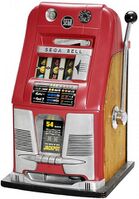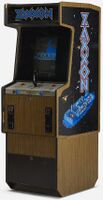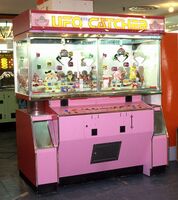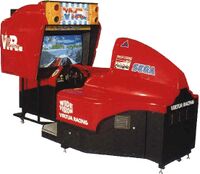Difference between revisions of "Sega"
From Sega Retro
(→Toys) |
|||
| Line 44: | Line 44: | ||
The existence of dedicated venues has allowed Sega to create much larger projects over the years, including indoor rides and movie theaters. They have also proved convenient spots for location testing of arcade machines. | The existence of dedicated venues has allowed Sega to create much larger projects over the years, including indoor rides and movie theaters. They have also proved convenient spots for location testing of arcade machines. | ||
| − | === | + | ===Consumer products=== |
| − | + | Throughout its history, Sega has occasionally ventured into the toy and consumer electronics markets. Of particular note is its takeover of Yonezawa Toys in 1994, leading to the creation of what would eventually become known as [[Sega Toys]] in 1998. As the largest post-War toy manufacturer in Japan, Yonezawa's incoporation into the Sega family meant that, for a time, Sega was a market leader in the Japanese toy market, with strong links to [[Hasbro]] in the United States. However, while Sega Toys continues to exist, it is currently managed as a separate entity within Sega Sammy Holdings. | |
| − | + | Sega has also produced karaoke equipment ([[Prologue 21]]), a digital camera ([[Digio SJ-1]]), a television ([[Sega-Vision]]), PDAs ([[IR 7000 Communicator]]) and has published films on VHS cassette. It has created films and cartoon shows with partners such as [[TMS Entertainment]], and its properties have been used to create books, albums, board games and audiobooks. | |
==Notable products== | ==Notable products== | ||
Revision as of 13:00, 14 May 2017
Sega (セガ) is an international digital entertainment and media company currently headquartered in Ota, Tokyo, Japan. Founded in the mid-1940s, Sega experienced rapid growth in the 1980s and 1990s to become one of the dominant forces in its field. It remains to this day a major player in the worldwide video game industry, covering arcade, console, handheld, mobile and PC markets.
Since 2004, Sega operates under a collective holding company known as Sega Sammy Holdings, formed after a merger between what was then Sega Corporation and Sammy Corporation. In April 2015 the Sega side of the business was sub-divided into three; Sega Games, handling the video game consumer business, Sega Interactive, which deals with the development and production of arcade games, and Sega Entertainment, responsible for the running of commercial venues[1]. In practice, all divisions and groups within the company are generally referred to and known collectively as "Sega".
Contents
History
- Main article: History of Sega.
Business interests
Amusement machines
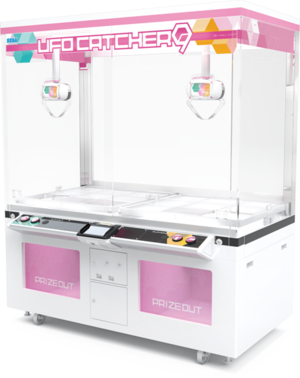
For most of its existence, Sega has been catering for the amusement industry, and alongside Namco and Taito, was seen as one of the major players in the Japanese market during the second half of the 20th century. While the sector has declined from its heights in the 1980s and early 1990s, Sega remains a prolific manufacturer of arcade machines, placing a specific emphasis on its home market of Japan.
The bulk of Sega's amusement machine business involves the creation of "rhythm" games and networked titles, sometimes relying on a physical component such as cards allowing players to save their progress or high scores. Sega has placed a high value on the use of the internet, allowing players to compete between arcade venues and keep track of their status through apps for mobile devices.
While the arcade industry has declined significantly in Western markets since its peak in the 1980s, Sega continues operate amusement businesses in the US and Europe, distributing products by third-party manufacturers and maintaining (and refurbishing) the company's older back-catelogue of racing and shooting games. Popular releases such as Daytona USA and Sega Rally Championship, despite being more than two decades old, are still often seen in active service and are staples of what little remains of the arcade scene. Likewise, these branches continue to oversee the development of new releases targeting a Western audience.
In addition to creating arcade video games, Sega has ventured into other areas of the amusement business, from change machines to motion simulators. Since 1985 Sega has been producing UFO Catcher machines; popular "crane" games which have been a permanent fixture of Japanese game centres since the late 1980s. Sega have a significant stake in this market, for as well as constructing the cabinets themselves, the company also sources and distributes the prizes.
Video games
Sega has been directly involved in the home "consumer" video game market since 1983, doubling up in the first eighteen years as a hardware manufacturer. During this time the company has created a number of lucrative franchises which are still actively maintained to this day, most notably the Sonic the Hedgehog series whose eponymous lead character has become a mascot for the company.
Sega supports home video game consoles and handhelds from platform holders Nintendo, Sony and Microsoft, as well as mobile devices such as smartphones and tablets, and the PC market, supported by Western subsidiaries The Creative Assembly, Sports Interactive and Relic Entertainment.
The company has a number of internal development studios based in Japan, with resources often shared between consumer and arcade projects. With the exception of localisation support and marketing, very little development work currently resides outside of Japan, with Sega winding down Sega of America's R&D departments in the late 1990s.
With the purchasing of Index Holdings in the summer of 2013, Atlus now resides as part of the Sega-Sammy family and also shares development resouces with Sega's Japanese studios.
Entertainment venues
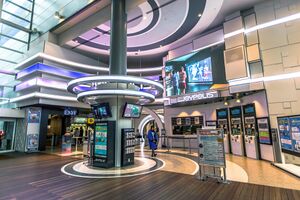
In addition to producing amusement machines, Sega owns a large portfolio of properties in which consumers can access them. Sega opened the first of its many Japanese "game centers" in the late 1960s, likely peaking at 870 sites across Japan in 1999[2], including an array of Joypolis indoor amusement parts, Sega World and Club Sega amusement arcades, and a number of spa and leisure facilities. It also operates the Orbi indoor nature attraction, developed in conjunction with BBC Worldwide.
In addition, Sega owns and operates Sega Republic in the UAE and a small number of venues in Taiwan and China. Cashflow problems, its merger with Sammy and subsequent restructuring in the mid-2000s led to Sega parting with many of its overseas entertainment venues, including the GameWorks chain in the US, Sega Worlds stationed in Australia and South Korea, and its numerous arcades spread across Europe, most notably the Joypolis-inspired SegaWorld London in 1999.
The existence of dedicated venues has allowed Sega to create much larger projects over the years, including indoor rides and movie theaters. They have also proved convenient spots for location testing of arcade machines.
Consumer products
Throughout its history, Sega has occasionally ventured into the toy and consumer electronics markets. Of particular note is its takeover of Yonezawa Toys in 1994, leading to the creation of what would eventually become known as Sega Toys in 1998. As the largest post-War toy manufacturer in Japan, Yonezawa's incoporation into the Sega family meant that, for a time, Sega was a market leader in the Japanese toy market, with strong links to Hasbro in the United States. However, while Sega Toys continues to exist, it is currently managed as a separate entity within Sega Sammy Holdings.
Sega has also produced karaoke equipment (Prologue 21), a digital camera (Digio SJ-1), a television (Sega-Vision), PDAs (IR 7000 Communicator) and has published films on VHS cassette. It has created films and cartoon shows with partners such as TMS Entertainment, and its properties have been used to create books, albums, board games and audiobooks.
Notable products
Sega Bell (1957), rebranded High Top slot machines from Mills, and the first product to bear the "Sega" name.
Sega 1000 (1960), Sega's first home-grown product. Cheap jukeboxes negating the need for imports in Japan.
Periscope (1966), Sega's first successful electro-mechanical arcade machine.
Zaxxon (1982), a staple of US arcades in the early 1980s.
UFO Catcher (1985), the genesis of crane games in Japan.
The Sega Mega Drive (1988), pictured here with its many add-ons: the Sega Mega-CD, 32X, Mega Modem and Karaoke.
Virtua Racing (1992), milestone in the video game racing genre.
Print Club (1995), a phenomeon amongst Japanese teenagers in the late 1990s.
The Dreamcast (1998), Sega's online-enabled "super console", and an end of an era.
Gallery
External links
References
| Early Sega | |||||||||||||||||||||||||||||||||||||||
| 45 | 46 | 47 | 48 | 49 | 50 | 51 | 52 | 53 | 54 | 55 | 56 | 57 | 58 | 59 | 60 | 61 | 62 | 63 | 64 | 65 | 66 | 67 | 68 | 69 | 70 | 71 | 72 | 73 | 74 | 75 | 76 | 77 | 78 | 79 | 80 | 81 | 82 | 83 | 84 |
|---|---|---|---|---|---|---|---|---|---|---|---|---|---|---|---|---|---|---|---|---|---|---|---|---|---|---|---|---|---|---|---|---|---|---|---|---|---|---|---|
| Service Games | Gulf+Western | ||||||||||||||||||||||||||||||||||||||
| Service Games, Hawaii & Nevada & Japan | Nihon Goraku Bussan & Nihon Kikai Seizou | Sega Enterprises, Inc. | |||||||||||||||||||||||||||||||||||||
| Sega Enterprises, Ltd. | Sega Ltd. & Gremlin | Sega Ltd. | |||||||||||||||||||||||||||||||||||||
| Timeline of Sega of Japan research and development divisions |
|---|
|
83
84
85
86
87
88
89
90
91
92
93
94
95
96
97
98
99
00
01
02
03
04
05
06
07
08
09
10
11
12
13
14
15
16
17
18
19
20
21
22
|
